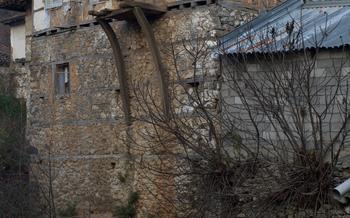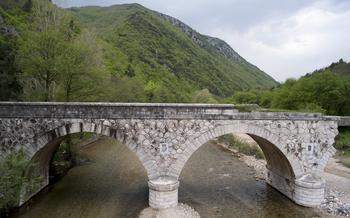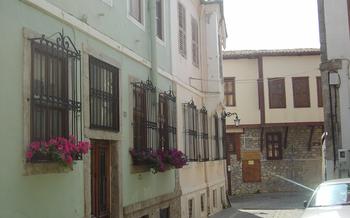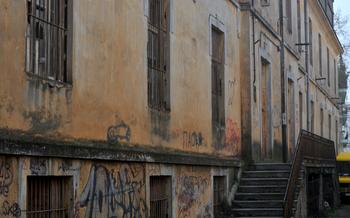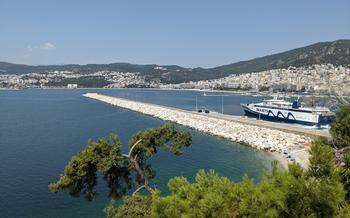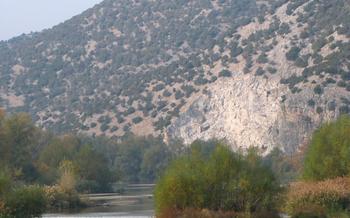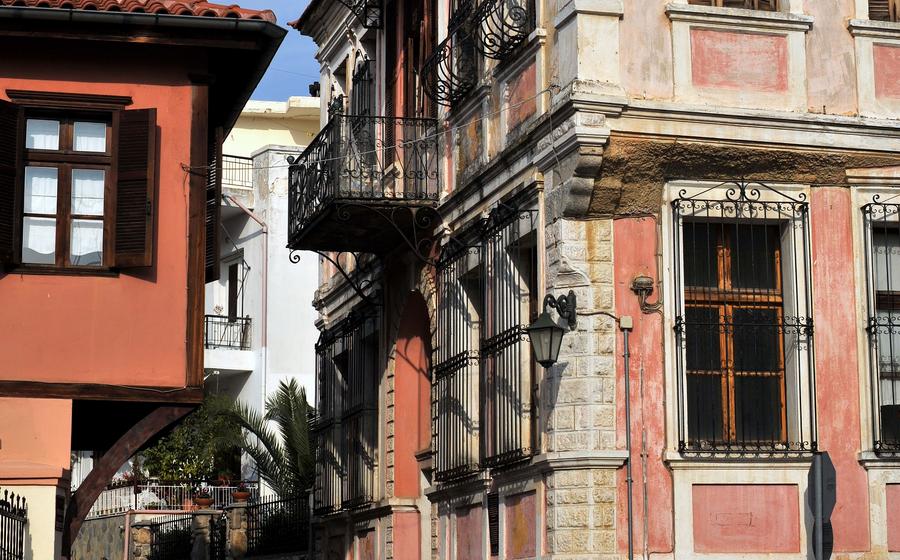
The Old Aqueduct of Xanthi
- The Old Aqueduct of Xanthi: A Timeless Landmark
- Exploring the Aqueduct's History
- Strolling Along the Aqueduct
- The Aqueduct's Architectural Features
- The Aqueduct's Cultural Significance
- The Aqueduct as a Tourist Attraction
- The Aqueduct and Local Traditions
- The Aqueduct's Role in Water Management
- The Aqueduct and Sustainable Tourism
- The Aqueduct's Restoration and Preservation
- The Aqueduct's Contribution to Urban Development
- The Aqueduct as a Symbol of Unity and Cooperation
- The Aqueduct in Art and Literature
- Insider Tip: Unveiling Hidden Gems Nearby
The Old Aqueduct of Xanthi: A Timeless Landmark
Historical Significance: In the heart of Xanthi, Greece, stands a testament to the city's rich history - the Old Aqueduct. Built in the 18th century during the Ottoman period, this magnificent structure served as a crucial water supply system, bringing life-giving water to the city's inhabitants. Its construction marked a significant milestone in Xanthi's development, showcasing the ingenuity and foresight of its people.
Architectural Marvel: The Old Aqueduct is not just a functional structure but also a stunning architectural marvel. Comprising a series of elegant stone arches that gracefully span the landscape, it exhibits intricate craftsmanship and a harmonious blend of form and function. The aqueduct's imposing presence and timeless design have earned it recognition as one of Xanthi's most iconic landmarks.
Panoramic Views: Perched atop an elevated vantage point, the Old Aqueduct offers breathtaking vistas of the surrounding countryside. From its arches, visitors can capture panoramic views of Xanthi's cityscape, the rolling hills, and the shimmering waters of the Nestos River in the distance. This unique perspective provides a memorable backdrop for photographs and a chance to appreciate the region's natural beauty.
Cultural Symbol: The Old Aqueduct stands as a proud symbol of Xanthi's rich cultural heritage and the resilience of its people. It represents the city's ability to adapt and thrive throughout history, preserving its traditions while embracing progress. The aqueduct's enduring presence serves as a reminder of the deep connection between Xanthi's past and present, making it a cherished landmark for both locals and visitors alike.
Exploring the Aqueduct's History
The Old Aqueduct of Xanthi holds a rich historical significance, dating back to the 18th century when it was constructed under Ottoman rule. During this period, the aqueduct played a pivotal role in transforming the city's development, serving as a crucial water supply system that provided a reliable source of water for the growing population. The aqueduct's innovative engineering techniques, utilizing local stone and traditional construction methods, ensured a steady flow of water, demonstrating the ingenuity and resourcefulness of its builders. Over time, the aqueduct has undergone various transformations, transitioning from a purely functional structure to a beloved landmark that embodies the resilience and spirit of Xanthi's people. Its enduring presence stands as a testament to the enduring legacy of the city's past.
Strolling Along the Aqueduct
Strolling alongside the Old Aqueduct of Xanthi is a delightful experience that combines natural beauty with historical charm. Immerse yourself in the picturesque setting as you traverse the path that runs parallel to the aqueduct, surrounded by lush greenery and vibrant landscapes. The peaceful ambiance offers a welcome respite from the hustle and bustle of the city, allowing you to reconnect with nature's serenity. As you walk, take your time to discover hidden corners and capture stunning photographs of the aqueduct from various angles, creating a unique collection of memories. Embrace the opportunity to slow down, appreciate the simple pleasures of life, and gain a deeper appreciation for the beauty and history that Xanthi holds.
The Aqueduct's Architectural Features
The Old Aqueduct of Xanthi stands as a testament to the ingenuity and craftsmanship of its builders. Its series of stone arches is a remarkable feat of engineering, creating a mesmerizing visual display that has captivated visitors for centuries. The arches, constructed from local stone, exhibit a harmonious blend of strength and elegance. Their graceful curves and precise alignments showcase the skill and dedication of the artisans who created them.
Admire the intricate carvings and decorative elements that adorn the aqueduct, adding to its aesthetic charm. These carvings, often depicting floral motifs or geometric patterns, reflect the rich artistic traditions of the region. The combination of stone arches, intricate carvings, and durable materials creates a visually stunning structure that blends seamlessly with the surrounding landscape.
The Aqueduct's Cultural Significance
The Old Aqueduct of Xanthi holds immense cultural significance, transcending its role as a mere water supply system. It stands as a testament to Xanthi's rich heritage and the resilience of its people. Over the centuries, the aqueduct has borne witness to countless events, embodying the city's triumphs and tribulations.
For the people of Xanthi, the aqueduct is a source of immense pride. It is a tangible reminder of their ancestors' ingenuity and determination. The aqueduct's enduring presence has fostered a deep sense of attachment and belonging among the locals, who regard it as an integral part of their identity.
The aqueduct is also a repository of stories and legends that have been passed down through generations. These tales, often intertwined with history and myth, add to the aqueduct's mystique and cultural significance. Locals believe that the aqueduct possesses magical powers and that it is a source of good fortune.
The aqueduct's cultural value extends beyond its local significance. It is recognized as a national monument of Greece, attracting visitors from around the world. Its unique architectural features and historical importance have earned it a place among the country's most cherished landmarks. The aqueduct is a symbol of Greece's rich cultural heritage and a testament to the enduring spirit of its people.
The Aqueduct as a Tourist Attraction
The Old Aqueduct of Xanthi has emerged as a prominent tourist attraction, captivating visitors with its historical charm and scenic allure. Its unique architectural features, combined with the breathtaking views it offers, make it a must-visit destination for anyone exploring the region. As you stroll along the aqueduct, you'll be treated to panoramic vistas of the city and the surrounding countryside, providing a perfect backdrop for capturing unforgettable moments. Whether you're a history buff, an architecture enthusiast, or simply seeking a tranquil escape, the Old Aqueduct promises an enriching and memorable experience.
The Aqueduct and Local Traditions
The Old Aqueduct of Xanthi is not just a historical landmark but also an integral part of the city's cultural fabric. Its presence has influenced local traditions, festivals, and events that celebrate the heritage of Xanthi and its people.
One of the most notable events is the annual Xanthi Carnival, held during the pre-Lenten period. The carnival features colorful parades, music, dancing, and elaborate costumes that fill the streets surrounding the aqueduct. The aqueduct serves as a backdrop for these vibrant celebrations, adding to the festive atmosphere.
Throughout the year, various cultural events and exhibitions are organized near the aqueduct, showcasing traditional Greek music, dance, and art. These events provide an opportunity for visitors to immerse themselves in the local culture and experience the warmth and hospitality of the Xanthi people.
For those looking to savor the flavors of the region, there are numerous tavernas and restaurants located near the aqueduct that offer traditional Greek cuisine. Visitors can indulge in delicious dishes prepared with fresh local ingredients, accompanied by the stunning views of the aqueduct and the surrounding landscape.
Shopping enthusiasts can find unique handicrafts and souvenirs inspired by the aqueduct and Xanthi's rich heritage at nearby shops and markets. These include intricate pottery, handwoven textiles, and locally produced delicacies that make for memorable keepsakes or gifts.
The Aqueduct's Role in Water Management
The Old Aqueduct of Xanthi once played a crucial role in supplying water to the city. Constructed during the 18th century, it served as a vital infrastructure, channeling water from nearby springs and rivers to meet the needs of the growing population. Its intricate system of channels, arches, and reservoirs ensured a steady and reliable water supply, contributing to the city's overall development and prosperity.
In modern times, the aqueduct's role in water management has evolved. While it no longer serves as the primary water source for Xanthi, it remains a significant symbol of the city's water heritage. Preservation efforts focus on maintaining its structural integrity and exploring sustainable ways to utilize its water resources.
Local communities are actively involved in preserving the aqueduct's legacy, implementing eco-friendly initiatives to minimize the environmental impact of tourism in the area. These efforts include promoting responsible water usage, raising awareness about the importance of water conservation, and implementing sustainable practices in nearby businesses and attractions.
By balancing tourism development with the preservation of the aqueduct's historical and cultural significance, Xanthi aims to ensure that this iconic landmark continues to stand as a testament to the city's rich water history and its commitment to sustainable water management practices.
The Aqueduct and Sustainable Tourism
The Old Aqueduct of Xanthi is not just a historical landmark but also a symbol of sustainable tourism. The local community recognizes the importance of preserving the aqueduct's heritage while promoting responsible tourism practices. Visitors are encouraged to embrace sustainable travel by choosing eco-friendly transportation options, reducing their carbon footprint, and respecting the natural environment surrounding the aqueduct. Local initiatives focus on minimizing waste, promoting energy efficiency, and supporting local businesses that prioritize sustainability. By embracing these practices, tourists can contribute to the preservation of the aqueduct and its surroundings while enjoying an authentic and responsible travel experience.
The Aqueduct's Restoration and Preservation
The Old Aqueduct of Xanthi has undergone extensive restoration and preservation efforts over the years to ensure its structural integrity and historical value. These endeavors have been driven by a deep appreciation for the aqueduct's significance as a cultural heritage site and a commitment to preserving it for future generations.
Challenges faced during the restoration process included addressing the effects of time, weathering, and natural disasters. Skilled artisans and engineers collaborated to meticulously repair damaged sections of the aqueduct, using traditional techniques and materials to maintain its authenticity.
Despite the challenges, the restoration efforts have been met with remarkable success. The aqueduct now stands as a testament to the dedication and expertise of those involved in its preservation. Regular maintenance and monitoring are ongoing to ensure that the aqueduct continues to endure as a symbol of Xanthi's rich history and enduring spirit.
Future plans for the aqueduct include further enhancements to its surroundings, such as landscaping and the creation of educational exhibits. These initiatives aim to make the aqueduct a more accessible and engaging destination for visitors, while also preserving its historical significance for generations to come.
The Aqueduct's Contribution to Urban Development
The Old Aqueduct of Xanthi played a crucial role in shaping the urban development of the city. Its construction in the 18th century marked a significant milestone in Xanthi's growth and prosperity. The aqueduct provided a reliable and abundant water supply to the city, which was essential for supporting its growing population and economic activities.
The availability of water from the aqueduct facilitated the expansion of Xanthi's urban areas. New neighborhoods sprang up, and existing ones grew denser as people moved closer to the source of water. The aqueduct's presence also spurred the development of industries and businesses that required a steady supply of water, such as textile mills and tanneries.
In addition to its practical benefits, the aqueduct also had a significant aesthetic impact on Xanthi's cityscape. Its imposing structure and graceful arches became a defining feature of the city's skyline, earning it the nickname "The Bride of Xanthi." The aqueduct's unique architectural style and historical significance have made it a beloved landmark among locals and visitors alike.
Today, the Old Aqueduct of Xanthi continues to stand as a testament to the ingenuity and resilience of the city's people. Its contribution to urban development and its enduring cultural significance make it a cherished symbol of Xanthi's rich history and heritage.
The Aqueduct as a Symbol of Unity and Cooperation
The construction and maintenance of the Old Aqueduct of Xanthi were a testament to the unity and cooperation among different communities. People from diverse backgrounds came together, sharing their skills and resources to bring this remarkable structure to life. The aqueduct stands as a symbol of their collective efforts and the shared desire to improve the city's infrastructure.
The aqueduct also represents the resilience and determination of the people of Xanthi in overcoming challenges together. Throughout its history, the city has faced various hardships, including natural disasters and economic downturns. However, the aqueduct has remained a source of strength and unity, reminding the people of their ability to work together and overcome adversity.
Today, the aqueduct continues to foster a sense of community and identity among the people of Xanthi. It is a beloved landmark that brings people together, serving as a venue for festivals, events, and gatherings. The aqueduct is a reminder of the power of collaboration and the shared heritage that unites the people of Xanthi.
The Aqueduct in Art and Literature
The Old Aqueduct of Xanthi has served as a captivating muse for artists, writers, and poets throughout history, inspiring creative works of art and literature that capture its essence and significance. Paintings, sculptures, and literary works depict the aqueduct from various perspectives, showcasing its architectural grandeur and its role in the cultural fabric of Xanthi. These artistic representations not only celebrate the beauty and heritage of the aqueduct but also contribute to its enduring legacy.
Local artists have found inspiration in the aqueduct's unique form and historical significance, creating paintings that depict its majestic arches against the backdrop of the Xanthi countryside. Sculptors have immortalized the aqueduct in bronze and stone, capturing its intricate details and conveying its strength and resilience. Poets, in turn, have penned verses that evoke the emotions and memories associated with the aqueduct, weaving tales of love, loss, and the enduring spirit of the Xanthi people.
The aqueduct has also facilitated cultural exchange, connecting Xanthi with other regions through artistic representations. Artists from around the world have visited Xanthi to capture the essence of the aqueduct, bringing their own unique perspectives and styles to their work. These artistic exchanges have enriched the cultural heritage of Xanthi and contributed to the aqueduct's recognition as a symbol of the city's creativity and cultural diversity.
Insider Tip: Unveiling Hidden Gems Nearby
While exploring the Old Aqueduct of Xanthi, don't miss the opportunity to venture beyond the main tourist trail and uncover hidden gems that offer a deeper connection with the region. Here are some insider tips to help you discover the lesser-known treasures that await:
-
Explore the Village of Genisea: A short drive from the aqueduct, the village of Genisea invites you to step back in time. Wander through its charming cobblestone streets, admire traditional architecture, and indulge in local delicacies at one of the village's tavernas.
-
Hike to the Waterfall of Livaditis: For nature enthusiasts, embark on a scenic hike to the mesmerizing Waterfall of Livaditis. Follow the meandering trails through lush forests, and let the sound of cascading water guide you to this hidden gem.
-
Visit the Folk Art Museum of Xanthi: Immerse yourself in the rich cultural heritage of the region at the Folk Art Museum of Xanthi. Discover an impressive collection of traditional costumes, textiles, and artifacts, showcasing the vibrant artistry of the local people.
-
Shop for Local Delights: Support the local economy by visiting the traditional shops and markets near the aqueduct. Browse for unique handicrafts, sample regional delicacies like koulouri (sesame bread rings) and pasteli (sesame and honey bars), and take home a taste of Xanthi's culinary treasures.
-
Explore the Surrounding Countryside: Rent a bicycle or embark on a leisurely walk through the picturesque countryside surrounding the aqueduct. Discover hidden chapels, serene rivers, and breathtaking panoramic views that will leave you in awe of nature's beauty.
